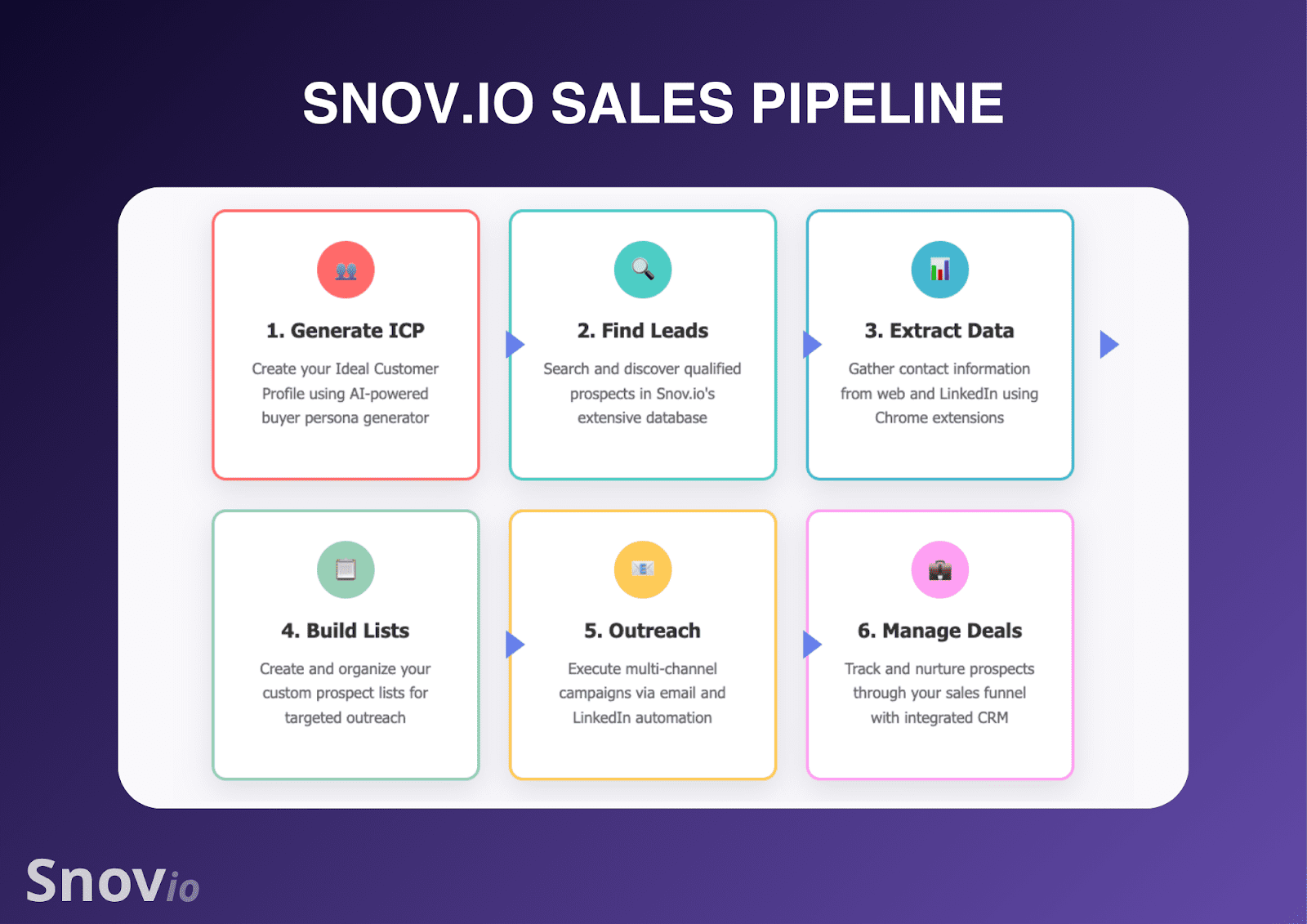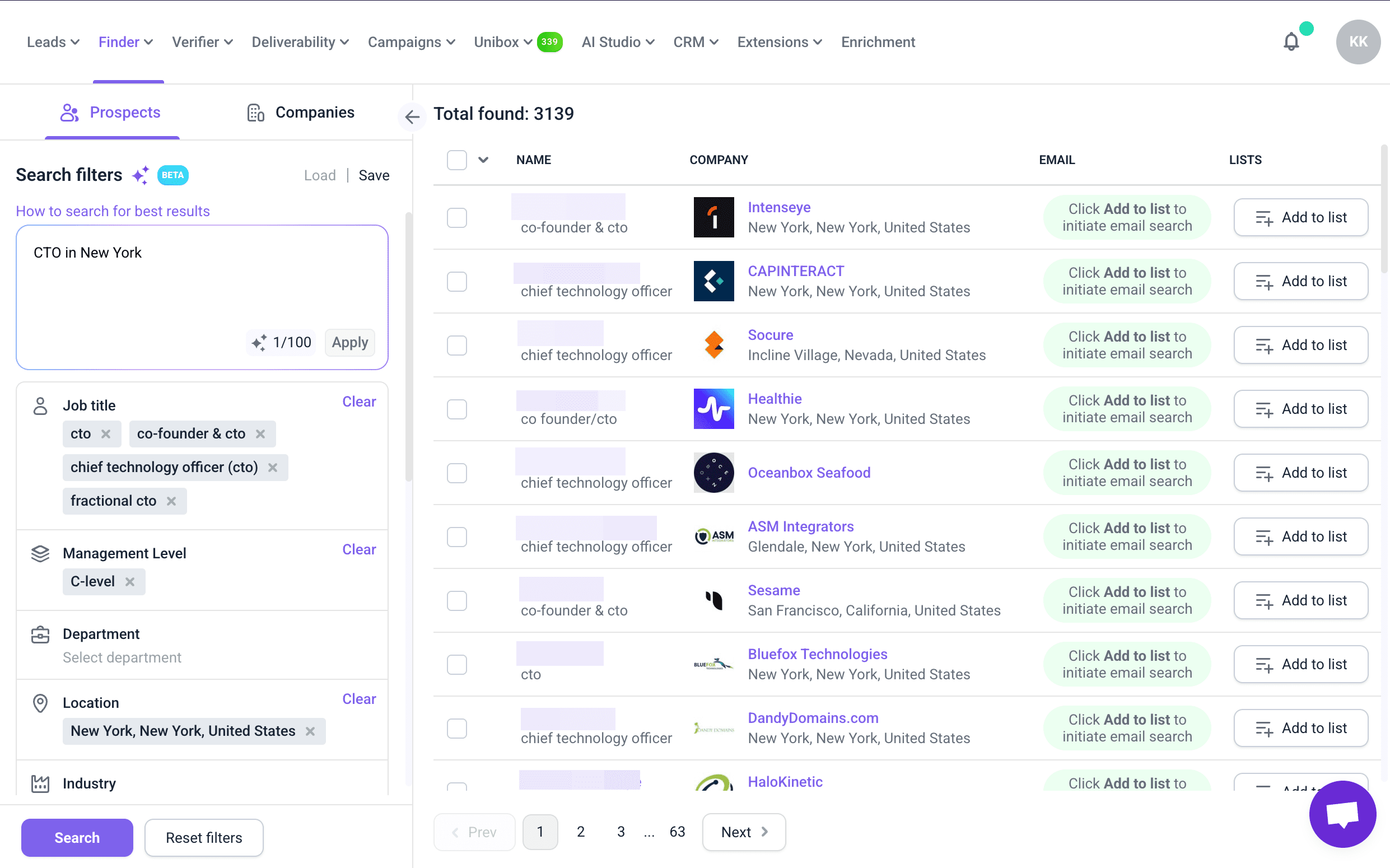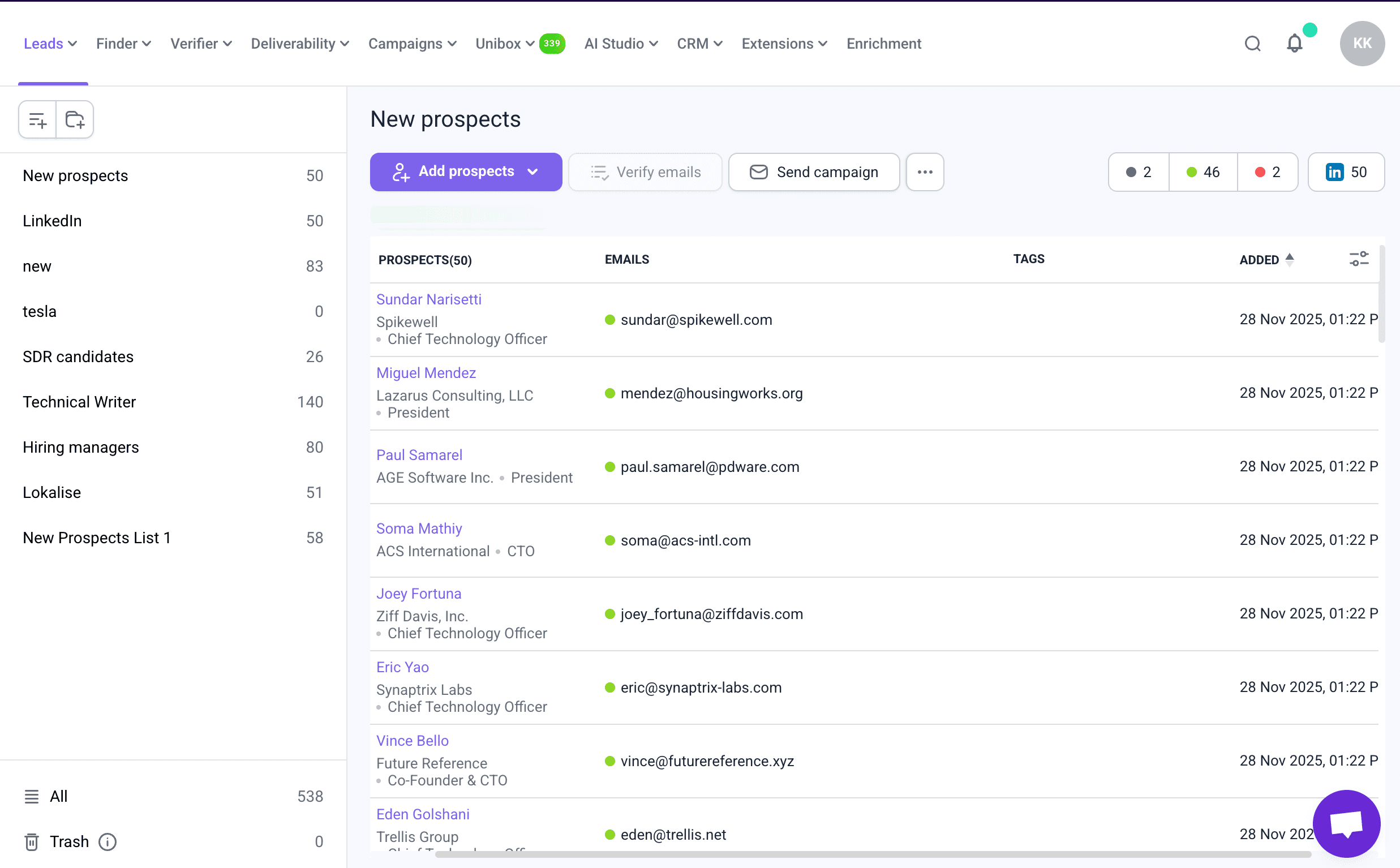TL;DR:
A modern B2B lead database is no longer just a static contact list – it’s a dynamic, automated system that collects, verifies, enriches, and integrates prospect data in real time. The best platforms today combine accuracy, security, and workflow integration to help teams reach qualified leads faster and with more relevant outreach.
In contrast to other database platform providers, who offer mainly prospecting features, Snov.io stands out with 50M+ company profiles provided in a sales lead database, AI-powered prospecting, and Email Finder that can scrape emails anywhere on the web.
It’s a huge mistake to think that starting as a B2B salesperson from scratch is easy. Sure, you might have the skills and know-how, but getting those initial leads can be pretty intimidating. You need to find initial lead data like company names, names of people responsible for purchasing decisions, and their social media accounts.
You can do this manually by scouting social media or large business rating websites like G2. Or, you can save yourself a headache and turn to prospecting software with a built-in lead database.
Outline:
What is a B2B lead database?
At the simplest level, a B2B lead database is a collection of contacts from other companies that you can use for your sales and marketing activities. It typically includes contact names, job titles, email addresses, social media profiles, and any other relevant information you may need to contact them and personalize your outreach.
But, in today’s market, a database would be more than just a static list to drive your business forward. The competition is so high, and people change jobs so frequently, that it becomes a real challenge to find valid and up-to-date information before someone else does.
Thus, modern B2B lead databases should provide the following:
- Automated data collection.
Instead of manually researching every prospect, access data in bulk from multiple reputable sources. This saves time and ensures you always have fresh new opportunities on hand without constant manual work.
- Regular data updates.
Thankfully, contact lists that you buy once and then try to use for years are a thing of the past. Now, reputable B2B lead databases must keep their data current, as this is the only way to maintain their usability.
- Real-time verification.
Avoid calling the wrong person or sending emails that bounce. Verification ensures that every contact in your database is active and reachable.
- Data enrichment.
Discover information about your prospects that goes beyond just address or phone number. Know their company size, tech stack, position, or even interests outside of work to personalize your outreach and truly connect with a prospective client.
- CRM integration.
Act on your data immediately without switching between multiple apps, thanks to the direct data exchange between your lead database and CRM.
Another essential quality that separates a modern usable B2B lead database platform from an outdated spreadsheet or a simple contact list is security. It should protect your prospects’ data with multiple layers of security mechanisms, complying with local and international security regulations (GDPR, CCPA, etc.).
But here’s the catch. There are so many database platforms out there, it’s hard to find the perfect one for your business. They may all look similar unless you try multiple ones.
Lead database platform comparison: Why choose Snov.io
To spare you this bothersome process, we gathered the key information about the five highest-rated lead database platforms below.
*The price is subject to change. Please check the provider’s website for up-to-date information.
As you can see, Snov.io has the best price-to-efficiency ratio. Our secret? Integrated functionality.
Integrated functionality vs fragmented solutions
Competitors like ZoomInfo, Cognizant, or Lusha provide strong lead search capabilities but require pairing with additional software for lead management and outreach. This not only adds complexity to the workflow but also increases the company’s expenses.
Snov.io, by contrast, is more than just a huge prospect database with advanced filtering capabilities. With our solution, you can execute your entire sales pipeline without leaving the app.
So, instead of searching for, trying out, and integrating multiple solutions, you can just join Snov.io and start working. This means you’ll get to close more deals and save money that would’ve otherwise been spent on additional software.
How to build your sales lead database with Snov.io
But what if you only need to build a prospect database? Let’s explore in more detail how you can do it with our best-of-the-market lead generation tools.
Utilize the advanced capabilities of the Snov.io Database Search
Unlike manual collection methods, which are slow and prone to error, our database provides fresh and accurate results quickly. Here’s how to get the best results:
- Define your ideal customer profile (ICP).
You can use our Buyer Persona Generator to generate your ICP based on your company profile.

We recommend providing as much contextual information as possible to ensure your ICPs are correct.
- Go to Database Search.
You have three options:
- Search for leads in the Prospects tab
- Search for businesses in the Companies tab
- Search for any type of prospects with the AI search
Our database contains 5M company contacts, and we continuously update it so you can be sure your B2B lead database stays up to date.
AI Database Search automatically adds filters, speeding up the process and making your prospecting more targeted.
- Add promising leads to your list.
- The system will automatically verify your leads’ contact information in real time. This way, you always receive the most up-to-date and accurate results.
You can find which prospects have LinkedIn accounts in case you want to expand your outreach.
- Now you can launch an outreach campaign.
Create deals in the built-in CRM, and otherwise manage your prospect list.
With this approach, building a database full of relevant reachable prospects becomes a repeatable, scalable process that takes minutes, not hours.
Clean up and enrich your existing prospect lists
Already have a prospect list stored in a spreadsheet file or another app, but unsure if it’s reliable? You can easily turn an outdated or incomplete list into a valuable part of your prospect base. Simply import your list into the app in one of the accepted formats and get started.
Use Email Verifier to instantly check the validity of every contact, removing hard bounces, spam traps, and inactive domains. Make list cleaning a habit. Even if you’ve built your list with verified emails, people switch addresses often, so annual list cleaning is a must.
Beyond cleaning, you can also enhance the quality of your records by filling in any missing details. Use our enrichment tools to add job titles, company sizes, LinkedIn profiles, and tech stack data to your prospects’ information.
This way, you’ll achieve higher deliverability and more personalized outreach without rebuilding your database from scratch.
Snov.io helped us collect more than 80,000 leads in a month, accelerating our search for emails while reducing the cost per lead.
CMO at Belkins
Cost-effective database building strategies
If you’re a little overwhelmed by the wide range of capabilities a database platform has to offer – don’t worry. Let us explain how all of the above fit into one database building strategy.
- Start with free and freemium tools.
Many lead generation platforms, including Snov.io, offer free plans or trial credits. These are perfect for testing workflows and collecting your first list of verified contacts without upfront investment.
- Focus on quality, not quantity.
Chasing thousands of leads might seem like a good business plan. But in reality, it’s far more cost-effective to build a smaller, verified list of prospects that closely match your ICP. This saves you from wasting resources on questionable leads and ultimately improves conversion rates.
- Clean and reuse collected data.
Don’t overlook your existing contact lists. Running them through verification to remove invalid or outdated emails is often cheaper than researching entirely new prospects.
- Add LinkedIn to your data sources.
Use advanced LinkedIn search filters to identify high-quality prospects. Then extract their contact information with specialized tools. For example, use our LinkedIn Email Finder Chrome extension (it’s free!).
- Scale gradually.
Start with a core database of 200–500 verified leads. Check that your lead sourcing and nurturing strategy and tech stack work, then expand your investment as revenue grows. This staged approach prevents overspending on useless data or tools.
Building scalable databases for enterprise teams
As you can see, our platform is user-friendly and powerful to fully cover the requirements of a small team or a solopreneur. But what happens when your company grows to an enterprise level? You’ll need collaboration, bulk processing, advanced reporting, and sophisticated security features. But it doesn’t mean you’ll have to buy a new prospecting solution.
Snov.io is designed to handle enterprise needs, providing features that allow teams to build and manage databases at scale.
Team collaboration and database management
Enterprise sales success depends on coordinated teamwork. With Snov.io, even the large teams can easily:
- Share databases across departments while keeping everything updated in real time.
- Use role-based permissions to manage access for admins, sales reps, and other employees.
- Track team activity and view how much revenue each sales team member brings to the business.
- Eliminate duplicate work with shared templates, prospects, and do-not-email lists.
Unlike competitors that require add-ons or external CRMs for team collaboration, our platform provides enterprise teams with a user-friendly, all-in-one workspace from day one.
Integration with the existing sales stack
However, if you already have a CRM, you don’t have to use ours! You can seamlessly integrate your system with the Snov.io platform. The same goes for other sales and marketing tools – we offer dozens of Zapier templates to cover enterprise needs.
What’s more, you can build tailored integrations even for the most elaborate custom tech stacks with our platform’s API capabilities. This ensures your prospect data moves automatically from acquisition to outreach, without manual exports or broken connections.
Database quality assurance and maintenance
Now, no matter how many fancy tools you use, a B2B database is only as effective as the quality of data it holds. Stale, inaccurate, or non-compliant contact records can ruin even the most sophisticated sales strategy. That’s why database quality assurance is essential.
A strong quality assurance framework typically means:
- Ensuring emails, phone numbers, and company details are valid and usable.
- Keeping records up-to-date as people change jobs, titles, or companies.
- Adhering to privacy and data protection laws like GDPR or CCPA.
While choosing a database platform, make sure it’s well-maintained by the provider. This includes ongoing enrichment, duplicate removal, and real-time validation processes that keep contact data current without requiring manual intervention.
Real-time data verification and updates
So how do we keep our data fresh? In addition to constant enrichment and expansion of our database, we rely on real-time data verification. In other words, we verify emails at the point of use, ensuring every client receives the most accurate data.
Here’s how it works:
- Syntax and domain checks ensure the address follows valid formats and the domain is active.
- MX record validation confirms that the receiving mail server can actually accept mail.
- SMTP simulations verify whether the mailbox exists without sending an actual email.
- Automated refresh cycles update existing records when job changes or domain changes are detected.
This real-time approach ensures more accurate targeting as contacts remain tied to current companies and job titles. It also reduces bounce rates and maintains the sender’s reputation.
Wrapping up
Here, we list the most cost-effective ways a novice B2B sales representative can hunt for leads. And if you need more information on the topic, we have other articles worth checking out! By using these resources and applying the described lead-sourcing techniques, you can identify potential prospects and feed your sales funnel.
With qualified and detailed contact profiles, you can be sure you’re on the right track to success in B2B sales. All the tools you need to compile the perfect database are in your Snov.io account. Don’t leave your B2B lead generation to chance – start smart and win the race against time to find your ideal customers from the start.








